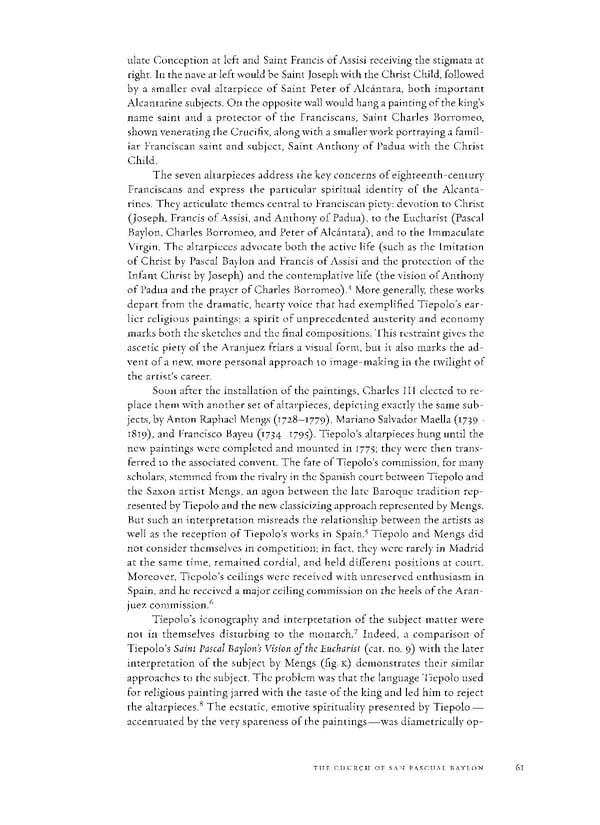ulate Conception at left and Saint Francis of Assisi receiving the stigmata at right. In the nave at left would be Saint Joseph with the Christ Child, followed by a smaller oval altarpiece of Saint Peter of Alcantara, both important Alcantarine subjects. On the opposite wall would hang a painting of the king's name saint and a protector of the Franciscans, Saint Charles Borromeo, shown venerating the Crucifix, along with a smaller work portraying a famil- iar Franciscan saint and subject, Saint Anthony of Padua with the Christ Child. The seven altarpieces address the key concerns of eighteenth-century Franciscans and express the particular spiritual identity of the Alcanta- rines. They articulate themes central to Franciscan piety: devotion to Christ (Joseph, Francis of Assisi, and Anthony of Padua), to the Eucharist (Pascal Baylon, Charles Borromeo, and Peter of Alcantara), and to the Immaculate Virgin. The altarpieces advocate both the active life (such as the Imitation of Christ by Pascal Baylon and Francis of Assisi and the protection of the Infant Christ by Joseph) and the contemplative life (the vision of Anthony of Padua and the prayer of Charles Borromeo).4 More generally, these works depart from the dramatic, hearty voice that had exemplified Tiepolo's ear- lier religious paintings; a spirit of unprecedented austerity and economy marks both the sketches and the final compositions. This restraint gives the ascetic piety of the Aranjuez friars a visual form, but it also marks the ad- vent of a new, more personal approach to image-making in the twilight of the artist's career. Soon after the installation of the paintings, Charles III elected to re- place them with another set of altarpieces, depicting exactly the same sub- jects, by Anton Raphael Mengs (1728-1779), Mariano Salvador Maella (1739- 1819), and Francisco Bayeu (1734-179$). Tiepolo's altarpieces hung until the new paintings were completed and mounted in 177$; they were then trans- ferred to the associated convent. The fate of Tiepolo's commission, for many scholars, stemmed from the rivalry in the Spanish court between Tiepolo and the Saxon artist Mengs, an agon between the late Baroque tradition rep- resented by Tiepolo and the new classicizing approach represented by Mengs. But such an interpretation misreads the relationship between the artists as 5 well as the reception of Tiepolo's works in Spain. Tiepolo and Mengs did not consider themselves in competition; in fact, they were rarely in Madrid at the same time, remained cordial, and held different positions at court. Moreover, Tiepolo's ceilings were received with unreserved enthusiasm in Spain, and he received a major ceiling commission on the heels of the Aran- juez commission.6 Tiepolo's iconography and interpretation of the subject matter were 7 not in themselves disturbing to the monarch. Indeed, a comparison of Tiepolo's Saint Pascal Baylon s Vision of the Eucharist (cat. no. 9) with the later interpretation of the subject by Mengs (fig. K) demonstrates their similar approaches to the subject. The problem was that the language Tiepolo used for religious painting jarred with the taste of the king and led him to reject 8 the altarpieces. The ecstatic, emotive spirituality presented by Tiepolo — accentuated by the very spareness of the paintings—was diametrically op- THE CHURCH OF SAN PASCUAL BAYLON 6l
 Giambattista Tiepolo: Fifteen Oil Sketches Page 61 Page 63
Giambattista Tiepolo: Fifteen Oil Sketches Page 61 Page 63